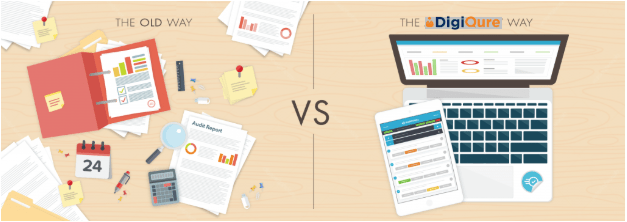That in common instances implies,
If a physician attends to 20 patients in a day, that’s around 500 patients in a month. So, a total of approximately 18,000 records needs to be maintained for the course of 3 years. The traditional method of keeping records that is followed in most of the hospitals across India is the manual method involving papers and books. There are serious limitations of manual record keeping including the need for large storage areas and difficulties in the retrieval of records. Unlike electronic medical records stored on cloud servers, paper medical records need physical space for storage purposes.
What do you do if there’s a fire that wipes out all your physical files? Or a moth infestation that, quite literally, eats up all your data? Paper records need to be in a moisture-free environment. Physical files, once lost, are impossible to recover. How to catalog these physical records is again a major issue. An electronic system doesn’t have these problems as records aren’t handwritten, so the legibility issue isn’t an issue at all. Plus you don’t have to search for patient files in a physical cabinet, while the software does that for you instantly.
All and all physical record keeping requires involvement of huge costs as compared to electronic records. These costs may be of physical files, books, storage closet, physical space etc.

Why still adamantly use paper in the era of Digitalization?
Paper production is the third most energy-intensive of all manufacturing industries, using over 12% of all energy in the industrial sector.⁽²⁾ The Institute of Medicine (IoM) implemented a research-study on paper record utilization in 1991. The conclusions from this report particularly endorsed the utilization of EHR as one of seven key recommendations for improving patient records, and to propose a means of converting paper to electronic records.
In the United States by 2004, the need to change over clinical records to EHRs was perceived broadly with the production of the Office of the National Coordinator (ONC) of Health Information Technology (IT). Soon after, EHRs were consolidated into the Health Information Technology for Economic and Clinical Health Act (HITECH), giving “higher installments to health care providers that meet ‘significant use’ measures, which include utilizing EHR for applicable purposes and meeting certain innovative necessities.” HIPAA guidelines were changed in accordance with electronic secured well-being data (ePHI) that was being kept up by these EHRs.
Today, the world sees the EHR as a safe and powerful instrument for keeping up a patient’s healthcare data information, for speaking with patients and different suppliers, and for supporting the patient-doctor relationship. Gone are the days of rearranging through paper documents, sitting tight for faxes, or scanning for desk work to have the option to give quality consideration to patients.

The Government of India took cognizance!
Under the Clinical Establishments(Registration and Regulation) Act,2010 which was assigned to regulate all clinical establishments in India, it has mentioned the mandating of digital record keeping. So much so that the Government of India intends to introduce a uniform system for maintenance of Electronic Medical Records / Electronic Health Records (EMR / EHR) by the Hospitals and healthcare providers in the country. An Expert committee was set up to develop EMR / EHR Standards for adoption / implementation in the country. Pertaining to the COVID-19 crisis, the GoI allowed Telemedicine and issued guidelines by the ministry of health and family welfare (MoHFW), on March 25, 2020.
Like they say it, “Longevity is to reinvent yourself or invent the future.” So, it seems pretty clear by all this that the future is digital. The traditional methods of record keeping are going to fade off and become obsolete. Only to be replaced by more efficient, faster and effective methods of electronic record keeping. So now is the time when you can switch to the futuristic ways of maintaining EHRs.
Thus, with the use of electronic health records (EHR) through a sophisticated tool such as DigiQure, one does not only has access to vital administrative operations such as Appointment Scheduling, Digital Prescription, Dynamic Website like Doctor’s profile page, Electronic Health Records, Billing & Payments, Patient Follow-ups & Medicine Reminders, Diagnostic Lab & Pharmacy Management, Analytics & Reports etc. But also this data is all the time available to be accessed from anywhere anytime from an absolutely secure cloud storage of Amazon Web Services.